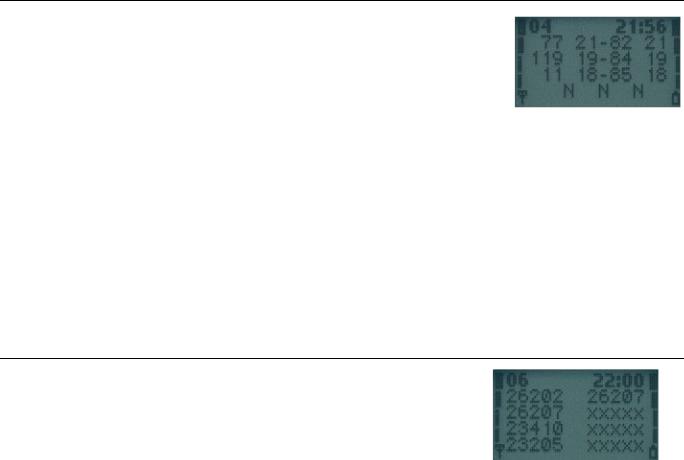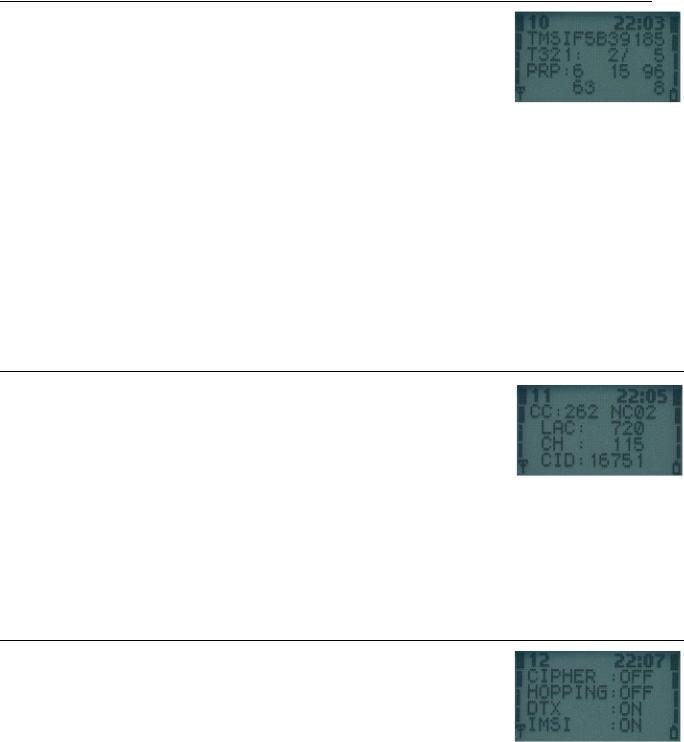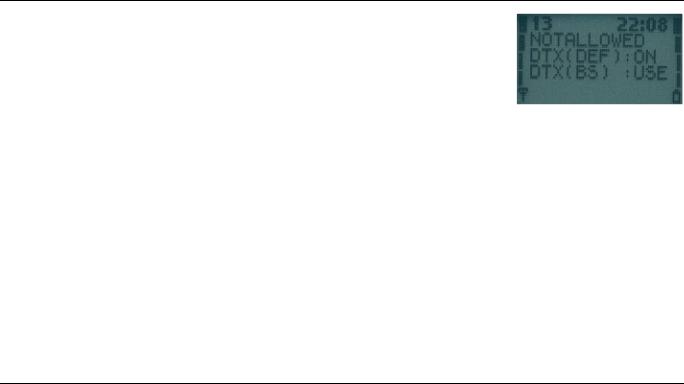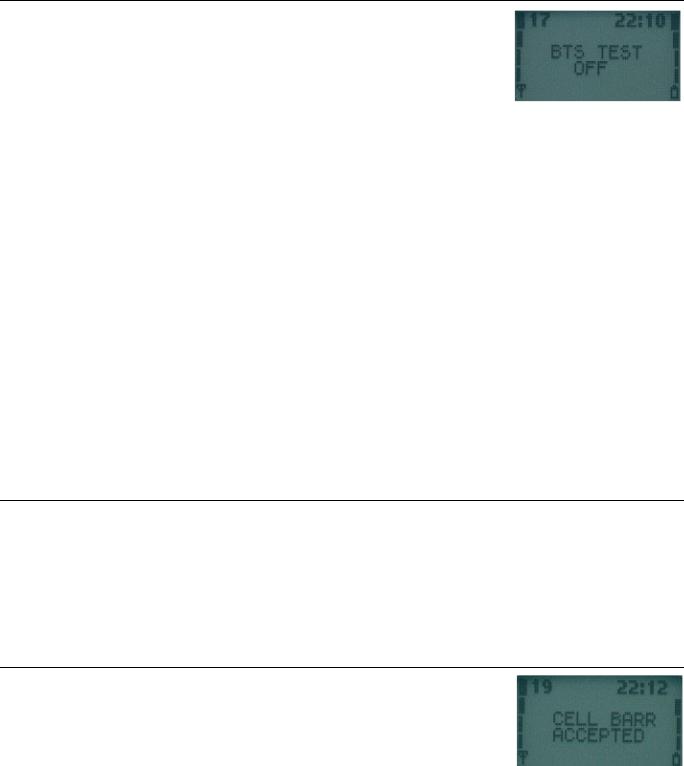Nokia 32XX, 81XX, 88XX, 61XX, 21XX User Manual
...Nokia
NetMonitor
Manual
Version 0.95
11.11.2002
Document keeper |
: nobbi (nobbi@nobbi.com) |
Base document |
: Flipo (flipo@gyral.com) |
PDF + Enhancements to base document |
: nobbi |
Graphics |
: nobbi |

Phone Models and Software versions
Notes for 21xx / 31xx / 81xx phones
The older phones netmonitor has some differences when compared with the one of newer models, but this manual can be used as a guide, because the overall working method and the display contents are very similar in most cases.
Notes for 51xx/61xx/62xx/71xx/88xx/91xx/32xx and other phones
This document covers the majority of pages from these phones netmonitor. Some of them may have little differences, like missing/additional pages, different info, etc.
The 51xx and 61xx pages are almost identical, there are a few pages concerning multiband information in 6150 which are different in the singleband phones, and the xx90 pages are partially different, because of some special things in GSM1900.
The 32xx has some more pages, which are not very well documented yet.
The 62xx and 71xx have a whole bunch of pages concerning W@P and the large internal flash memory. These are not documented yet. If you have any clue about theses pages, send me a mail.
The 91xx pages are almost identical to the 6110 ones, with few additional pages.
The goal right now is to make an accessible manual, that will get better over the time. Please contribute with all the info that you find relevant. Please note that this manual does only deal with pages which are of known content, so if a page is not mentioned here, I have most likely no knowledge about the meaning of the page.
Used Information Sources :
[ 1 ] |
Netmonitor description (RD843.txt) from Nokia Mobile Phones |
[ 2 ] |
Marcin Wiaceks homepage (http://marcin-wiacek.topnet.pl/) |
[ 3 ] |
Researches from Nobbi & various other people |
2

Menu Modes
There are three Menu Display modes:
-the execute mode
-the data display mode
-the help mode
Different modes are marked in this manual as follows:
************** |
++++++++++++++ |
############## |
||||||
* |
Execute |
* |
+ |
|
+ |
# |
Help |
# |
* |
* |
+Data display+ |
# |
# |
||||
* |
Mode |
* |
+ |
Mode |
+ |
# |
Mode |
# |
* |
|
* |
+ |
|
+ |
# |
|
# |
************** |
++++++++++++++ |
############## |
||||||
The execute mode is entered from the menu by selecting a menu directly with his number. If the test index entered pertains to a test that resets a timer (test 80) for example, then the timer is reset as soon as the OK button has been pressed in the menu, and the data display mode takes over. In other words, the execute mode is of the one-shot type. To run another test in the execute mode, the Field Test Display menu must be reactivated.
So, be very careful when jumping to a netmonitor page directly from the menu selection. You may activate the execute mode incidentally, causing your phone to behave not as expected.
The data display mode is active by default when the Netmonitor is active. During data display mode, the field test data is visible on the main display.
During help mode, one screen of instructions is shown for each test to make it easier to identify the test in question. A long press of the asterisk (*) is used to toggle between these two modes.
The arrow keys (^,v) offer an easy way to switch to another test without using the menu. However, nothing will be executed or set on although such tests would be passed. This is to prevent the user from accidentally clearing any valuable data. The help mode is also a non-execute mode. Display numbers have been selected in such way that no 5-terminated test number is an execute display.
Reserving SIM phonebook locations
When using a phone with enabled field test displays, it is highly recommended to put some default data into the SIM phonebook locations that are used by some field test displays. Especially Test 17 (BTS TEST) may give some confusing results if SIM phonebook location 33 is not correctly configured.
Additionally, this prevents accidental storing of phone numbers and names into such locations.
Displays 52 and 53 may also write some data to the SIM phonebook locations 35 and 36.
Location |
Default |
Data Used by Display # |
31 |
65535 |
71 |
32 |
65535 |
72 |
33 |
0 |
17 (BTS TEST) |
34,35,36 |
34,35,36 |
52, 53 |
Reserving SIM SCM locations is not necessary if the user is sure that he will never select these displays using menu shortcut (which executes the display in question).
3

Table of contents
Phone Models and Software versions ..................................................................................... |
2 |
Notes for 21xx / 31xx / 81xx phones...................................................................... |
2 |
Notes for 51xx/61xx/62xx/71xx/88xx/91xx/32xx and other phones....................... |
2 |
Menu Modes ............................................................................................................................ |
3 |
Reserving SIM phonebook locations ....................................................................................... |
3 |
Table of contents ..................................................................................................................... |
4 |
Basics: Channel numbers in GSM........................................................................................... |
4 |
Display 1 – Serving cell info..................................................................................................... |
5 |
Display 10 – Paging Repetition Period, TMSI, Location Update Timer, AFC and AGC ......... |
9 |
Display 20 – Charging state................................................................................................... |
12 |
Display 39 – Information about reasons for call clearing....................................................... |
16 |
Display 40 – Reset handover counters.................................................................................. |
17 |
Display 60 – Reset counters to zero...................................................................................... |
21 |
Display 65 – SMS attempts counters .................................................................................... |
23 |
Display 70 – Temporary counters of DSP ............................................................................. |
24 |
Display 80 – Reset and restart timers ................................................................................... |
28 |
Display 100 (7110, 62XX) – Internal memory usage, overview ............................................ |
31 |
Display 240 (no output) – Clear counters and start timers.................................................... |
34 |
Basics: Channel numbers in GSM
GSM uses channel numbers between 0 and 1023. These frequency channels are allocated by the different types of GSM as follows:
Type: |
Subtype: |
Channels: |
||
GSM400 |
GSM450 |
259 |
.. |
293 |
GSM700 |
GSM480 |
306 |
.. |
340 |
GSM750 |
438 |
.. |
511 |
|
GSM850 |
GSM850 |
128 |
.. |
251 |
GSM900 |
PGSM |
1 |
.. |
124 |
|
EGSM |
0 |
.. |
124 |
|
GSM-R |
975 |
.. 1023 |
|
|
0 |
.. |
124 |
|
GSM1800 |
GSM1800 |
955 |
.. 1023 |
|
512 |
.. |
885 |
||
GSM1900 |
GSM1900 |
512 |
.. |
810 |
4

Display 1 – Serving cell info
++++++++++++++ |
############## |
||||
+abbb ccc ddd+ |
#CH RxL TxPwr# |
||||
+ e ff g mmmm+ |
#TS TA RQ RLT# |
||||
+ nnn |
oooo |
ppp+ |
# C1 |
CHT |
C2 # |
+ |
+ |
# |
# |
||
++++++++++++++ |
############## |
||||
a |
H, if carrier numbers are scrolled when hopping is on. Otherwise ' '. |
||||
bbb |
When mobile is on a TCH : |
||||
|
|
DCH carrier number in decimal. |
|||
|
When mobile is NOT on a TCH : |
||||
|
|
CH means carrier number in decimal. |
|||
|
|
If hopping is on, used channels are scrolled when display is updated. |
|||
cccrx level in dBm, minus sign is not shown if <=-100
dddtx power level. If transmitter is on, symbol * is shown in front of the power level value.
e Time Slot, range is 0 - 7
ff Timing advance, range is 0 – 63 g RX quality (sub), range is 0 - 7
mmmmRadio Link Timeout value. If value is negative, 0 is shown. Maximum value is 64. When mobile is NOT on TCH then xx is shown.
nnn |
value of the path loss criterium (C1). Range is -99 - 999. |
||
oooo |
type of current channel (TCH := Traffic Channel): |
||
|
THR0 |
: TCH HalfRate (HR) subchannel 0 |
|
|
THR1 |
: TCH HR subchannel 1 |
|
|
TFR |
: TCH FullRate (FR) |
|
|
TEFR |
: TCH EnhancedFullRate |
|
|
F144 |
: TCH FR data channel, speed 14.4 kbps |
|
|
F96 |
: TCH FR data channel, speed 9.6 |
kbps |
|
F72 |
: TCH FR data channel, speed 7.2 |
kbps |
|
F48 |
: TCH FR data channel, speed 4.8 |
kbps |
|
F24 |
: TCH FR data channel, speed 2.4 |
kbps |
|
H480 |
: TCH HR data channel, speed 4.8 |
kbps, subch 0 |
|
H481 |
: TCH HR data channel, speed 4.8 |
kbps, subch 1 |
|
H240 |
: TCH HR data channel, speed 2.4 |
kbps, subch 0 |
|
H241 |
: TCH HR data channel, speed 2.4 |
kbps, subch 1 |
|
FA |
: TCH FR signalling only (FACCH) |
channel |
|
FAH0 |
: TCH HR signalling only (FACCH) |
channel, subch 0 |
|
FAH1 |
: TCH HR signalling only (FACCH) |
channel, subch 1 |
|
SDCC |
: SDCCH |
|
|
AGCH |
: Access Grant CHannel |
|
|
CCCH |
: one of the Common Control CHannels |
|
|
CBCH |
: CCCH and cell broadcast receiving on |
|
|
BCCH |
: Broadcast Control CHannel |
|
|
SEAR |
: SEARCHing for available networks |
|
|
NSPS |
: MS is in ’No Service, Power Save’ state |
|
pppvalue of the cell reselection criterium (C2).
Range is -99 to 999. If phone is phase 1 then C1 value is shown.
5

Display 2 – More info about serving cell
++++++++++++++
+ |
aa |
b |
c Bdd + |
+ |
ee |
f |
+ |
+ggg hh iii +
+H=j mm nn +
++++++++++++++
##############
#PM RAR Ro BC# #RelR QLF # #CRO TO PenT # #H MAIO HSN #
##############
aa paging mode
NO : normal paging EX : extended paging
RO : paging reorganization SB : same as before
bmaximum number of Random Access retransmission
croaming indicator, values are 'R' or ' '.
Bdd |
Letter B and BSIC value, range |
is 0 - 63. |
|
ee |
Reason of last call release |
(See Display 39, CC cause codes) |
|
f |
RX quality (full), range is |
0 - 7 |
|
ggg |
Cell reselection offset, range |
0 - 126 dB. |
|
hh |
[0 .. 63] * 2 dB. 'xxx' in dedicated mode. |
||
Temporary offset, range 0 - |
60 |
dB. |
|
|
[0 .. 7] * 10 dB. 70 dB means infinite time. |
||
iii |
'xx' in dedicated mode. |
|
|
Penalty time, range 0 - 620 |
s. |
|
|
j |
[0 .. 31] * 20 s. 'xxx' in dedicated mode. |
||
Hopping channel |
|
|
|
0Single RF channel
1RF hopping channel
mmmobile allocation index offset, MAIO
Range: 00 to 63 / xx when H=0 nn hopping sequence number, HSN
Range: 00 to 63 / xx when H=0
Display 3 – Serving cell, 1st and 2nd neighbour
++++++++++++++ |
############## |
||||
+aaabbbcccddd+ |
#SCH C1 |
rx C2# |
|||
+aaabbbcccddd+ |
#1CH C1 |
rx C2# |
|||
+aaabbbcccddd+ |
#2CH |
C1 |
rx C2# |
||
+ |
ef gh + |
# |
1N |
2N |
# |
++++++++++++++ |
############## |
||||
1.row: serving cell information
2.row: 1. neighbour information
3.row: 2. neighbour information
4.row, ef: 1. neighbour information
4.row, gh: 2. neighbour information
aaacarrier number in decimal, EGSM channels are displayed as Eaa
bbbidle mode : C1 value, range is -99 - 999 ded. Mode : 'B' and BSIC value
cccRX level in dBm, minus sign is not shown if <=-100
dddC2 value, range is -99 - 999
e,g |
F : cell |
is in a forbidden location area |
||
f,h |
B : cell |
is barred |
||
|
N |
: cell |
is |
normal priority |
|
L |
: cell |
is |
low priority |
6

Display 4 & 5 – 3rd to 8th neighbour cell
++++++++++++++ |
############## |
|
+aaabbbcccddd+ |
#3CH C1 |
rx C2# |
+aaabbbcccddd+ |
#4CH C1 |
rx C2# |
+aaabbbcccddd+ |
#5CH C1 |
rx C2# |
+ ef gh ij + |
# 3N 4N 5N # |
|
++++++++++++++ |
############## |
|
1.row: 3./6. neighbour information
2.row: 4./7. neighbour information
3.row: 5./8. neighbour information
4.row, ef: 3./6. neighbour information
4.row, gh: 4./7. neighbour information
4.row, ij: 5./8. neighbour information
aaacarrier number in decimal, EGSM channels are displayed as Eaa
bbbidle mode : C1 value, range is -99 - 999 ded. Mode : 'B' and BSIC value
cccrx level in dBm, minus sign is not shown if <=-100
dddC2 value, range is -99 - 999
e,g,i |
F : cell |
is in a forbidden location area |
||
f,h,j |
B : cell |
is barred |
||
|
N |
: cell |
is |
normal priority |
|
L |
: cell |
is |
low priority |
Display 6 – Network selection display
++++++++++++++ |
############## |
||
+aaabb |
aaabb+ |
#LReg |
1_For# |
+aaabb |
aaabb+ |
#1_Pre 2_For# |
|
+aaabb |
aaabb+ |
#2_Pre 3_For# |
|
+aaabb |
aaabb+ |
#3_Pre 4_For# |
|
++++++++++++++ |
############## |
||
This display shows the last registered networks country code (MCC) and network code (MNC) as well as the codes for four forbidden networks and the first 3 preferred networks.
If a three-digit MNC is used (GSM1900), display looks different:
++++++++++++++
+aaabbbaaabbb+
+aaabbbaaabbb+
+aaabbbaaabbb+
+aaabbbaaabbb+
++++++++++++++
1. |
row: last registered network - |
1st forbidden network |
|||||
2. |
row: 1st preferred network |
- |
2nd forbidden network |
||||
3. |
row: 2nd |
preferred |
network |
- |
3rd |
forbidden |
network |
4. |
row: 3rd |
preferred |
network |
- |
4th |
forbidden |
network |
aaacountry code coded in BCD
bbbnetwork code coded in BCD, third digit can be 'F'
7

Display 7 – System information bits for serving cell
++++++++++++++ |
############## |
|||
+E |
A H C I BR+ |
#Serving Cell# |
||
+a |
b c d e fg+ |
#System Info # |
||
+ECSC 2Ter MB+ |
#Bits |
# |
||
+ |
h |
i j+ |
# |
# |
++++++++++++++ |
############## |
|||
a1 is shown if emergency calls are supported
b1 is shown if attach-detach-procedure is allowed
c1 is shown if half rate channels are supported
d1 is shown if C2 values are broadcasted
e1 is shown if system information 7 and 8 are broadcasted
f1 is shown if cell broadcast is supported
g1 is shown if re-establishment is supported The following items are used only in dualband phones:
hIn idle mode 1 is shown if Early Classmark (ECSC) sending is supported. In dedicated mode (conversation) X is shown.
iIn idle mode 1 is shown if 2Ter messages are supported. In dedicated mode (conversation) X is shown.
jMultiBand reporting decimal value (0,1,2,3) is shown if supported. This is shown both in idle and dedicated mode.
The following is picked from Phase2+ ETSI ETS 300578 (TS GSM 05.08), Section 8.4.3 "Additional cell reporting requirements for multi band MS".
For a multi band MS the number of cells, for each frequency band supported, which shall be included in the measurement report is indicated by the parameter, MULTIBAND_REPORTING. The meaning of different values of the parameter is specified as follows:
Value Meaning
00 (0) Normal reporting of the six strongest cells, with known and allowed NCC part of BSIC, irrespective of the band used.
01 (1) The MS shall report the strongest cell, with known and allowed NCC part of BSIC, in each of the frequency bands in the BA list, excluding the frequency band of the serving cell. The remaining positions in the measurement report shall be used for reporting of cells in the band of the serving cell. If there are still remaining positions, these shall be used to report the next strongest identified cells in the other bands irrespective of the band used.
10 (2) The MS shall report the two strongest cells, with known and allowed NCC part of BSIC, in each of the frequency bands in the BA list, excluding the frequency band of the serving cell. The remaining positions in the measurement report shall be used for reporting of cells in the band of the serving cell. If there are still remaining positions, these shall be used to report the next strongest identified cells in the other bands irrespective of the band used.
11 (3) The MS shall report the three strongest cells, with known and allowed NCC part of BSIC, in each of the frequency bands in the BA list, excluding the frequency band of the serving cell. The remaining positions in the measurement report shall be used for reporting of cells in the band of the serving cell. If there are still remaining positions, these shall be used to report the next strongest identified cells in the other bands irrespective of the band used.
8

Display 10 – Paging Repetition Period, TMSI, Location Update Timer, AFC and AGC
++++++++++++++ |
############## |
||
+TMSIaaaaaaaa+ |
#TMSI(hex) |
# |
|
+T321:bbb/ccc+ |
#T3212ctr/tim# |
||
+PRP:d |
ee ff+ |
#PaRP DSF AGC# |
|
+ ggggg |
hhh + |
# AFC Ch |
# |
++++++++++++++ |
############## |
||
aaaaaaaa last assigned TMSI value in hex format
bbbCurrent value of T3212 counter (range is 000 - 'ccc'), where 1 means 6 min time. So, if this value is 2 less than 'ccc' then next periodic location updating will be made within 2 * 6 min = 12 minutes.
cccTimeout value of T3212 counter (range is 000 - 240, where 1 means 6 min time between location updates and 240 means 240 * 6 min = 24 h between location updates. 000 means that a periodic location update will not
occur) This value is received from the network.
dValue of paging repetition period (range is 2 – 9, which means paging will be in every Xth multiframe. When paging is in every second multiframe, mobile takes more current than if it were in every 9th multiframe)
eeDownlink signalling failure value. If value is negative, 0 is shown. Maximum value is 45. When mobile is on TCH then xx is shown.
ffGain value on TCH/SDCCH, range is 0 - 93
ggggg VCTCXO AFC DAC control, range is -1024 - 1023 hhh Serving cell channel number
Display 11 – Network parameters
++++++++++++++ |
############## |
||||
+CC:aaa NCbbb+ |
# MCC |
MNC # |
|||
+ LAC:ccccc |
+ |
#LocAreaCode # |
|||
+ CH : dddd |
+ |
#ServChannel |
# |
||
+ CID:eeeee |
+ |
# |
CellId |
# |
|
++++++++++++++ |
############## |
||||
aaaMCC value in decimal (MCC=Mobile Country Code)
bbbMNC value in decimal (MNC=Mobile Network Code)
Three digits are shown only in GSM1900. Two digits are shown in GSM900 and GSM1800.
ccccc LAC value in decimal (in older SW-versions this value is in hexadecimal) dddd Serving cell channel number
eeeeeCell Identifier in decimal (in older SW-versions this value is in hexadecimal)
Display 12 – Ciphering, hopping, DTX Status and IMSI
++++++++++++++ |
############## |
||
+CIPHER :aaa + |
#CipherValue # |
||
+HOPPING:bbb + |
#HoppingValue# |
||
+DTX |
:ccc + |
#DTXValue |
# |
+IMSI |
:ddd + |
#IMSIAttach |
# |
++++++++++++++ |
############## |
||
aaaciphering value, OFF/A51/A52
bbbhopping value, ON/OFF
cccDTX value ON/OFF
dddIMSI attach
ON : IMSI attach on
OFF : IMSI attach off
These values are updated only on when the phone is active on a TCH.
9

Display 13 – Uplink DTX switching display
************** |
############## |
||
*aaaaaaaaaa |
* |
#DTXMode |
# |
*DTX(DEF):bbb* |
#DefaulDTXSta# |
||
*DTX(BS) :ccc* |
#DTXValFromBS# |
||
* |
* |
# |
# |
************** |
############## |
||
With this display it is possible to see whether the MS uses DTX or not.
This display must be activated from MENU to change DTX state. When MENU is not active and the user is scrolling field test displays with NEXT and PREVIOUS, the DTX state will not be changed.
aaaaaaaaaa status of switched mode. |
|
||
DTX:ON |
: MS |
uses DTX |
use DTX |
DTX:OFF |
: MS |
does not |
|
DTX:DEF |
: MS |
use default state of DTX |
|
NOTALLOWED: BS |
does not |
allow MS to decide if it uses |
|
|
DTX or not. |
|
|
bbbdefault state of DTX in MS. The value is either ON or OFF
cccis DTX value from BS
MAY : BS allows MS to decide if it uses uplink DTX or not
USE : BS controls MS to use DTX (on uplink)
NOT : BS controls MS not to use DTX (on uplink)
Display 14 – Toggle Screening Indicator
************** |
############## |
|||
* |
SCREENING * |
#Use menu to # |
||
* |
INDICATOR |
* |
# change |
# |
* |
IS XX |
* XX : 00 or 01 |
# Screening |
# |
* |
|
* |
# indicator |
# |
************** |
############## |
|||
When selected, changes the value of the Screening Indicator from 0 to 1 and vice versa.
10

Display 17 – Switch 'BTS Test' Status
************** |
************** |
############## |
|||||
* |
BTS TEST |
* |
* |
BTS TEST |
* |
#Use menu to |
# |
* |
* |
* |
* |
#toggle BTS |
# |
||
* |
ON |
* |
* |
OFF |
* |
#test ON/OFF # |
|
* |
|
* |
* |
|
* |
# |
# |
************** |
************** |
############## |
|||||
This display is used to toggle the BTS_TEST flag in EEPROM. If BTS_TEST is set then each time the mobile sends a search list it uses only the carrier number stored on SIM phonebook location 33. Also the neighbour information from system information messages is ignored. If the BTS_TEST flag is not set, then the value of SIM phonebook location 33 is ignored and the mobile behaves normally (i.e. does neighbour measurements according to GSM specifications).
To activate BTS TEST perform the following steps:
-Save desired channel number in SIM phonebook location 33
-Select display 17 in execute mode
-Switch power off and on OR force a cell reselection
If activation succeeded, you will read "BTS TEST ON" in display 17. The 6210 will show "BTS TEST REQUESTED" instead.
To deactivate BTS tests either select display 17 in execute mode or save a number in SIM phonebook location 33 which does NOT represent a valid carrier number, then switch power off and on OR force a cell reselection
CAUTION! The display does not show the value of the BTS_TEST flag in EEPROM. Although the value is set, BTS_TEST can show to be off. If there is no legal carrier number in SIM phonebook location 33 (GSM900: 1-124, GSM1800: 512-885, EGSM: 0, 975-1023) the display shows that BTS_TEST is off. Also if the mobile was already registered to some carrier before switching BTS_TEST status, the display can show a different value from the one in EEPROM.
Display 18 – Lights status control
Forces keyboard and display lights on/off while displaying any netmonitor screen. The light will not remain on after leaving netmonitor
************** |
************** |
############## |
||||||
* |
LIGHTS |
* |
* |
LIGHTS |
* |
#Use menu to # |
||
* |
* |
* |
* |
# |
toggle |
# |
||
* |
ON |
* |
* |
OFF |
* |
# |
lights |
# |
* |
|
* |
* |
|
* |
# |
ON/OFF |
# |
************** ************** ##############
Display 19 – Toggle Cell Barred Status
************** |
************** |
************** ############## |
|||
* |
* |
* |
* |
* |
* #Use menu to # |
* CELL BARR |
* |
* CELL BARR |
* |
* CELL BARR |
* #toggle cell # |
* ACCEPTED |
* |
* REVERSE |
* |
* DISCARD |
* #barr status # |
* |
* |
* |
* |
* |
* #DIS/ACC/REV # |
************** |
************** |
************** ############## |
|||
This test is meant to be used when some cells are tested before taking them into commercial use. By setting the CELL_BARRED to on in the base station normal GSM phones will not try to camp on these barred cells.
By selecting CELL BARR REVERSE, the MS will only use the cells which have CELL_BARRED set.
By selecting CELL BARR DISCARD, the MS will use all cells, irrespective wether CELL_BARRED is set or not.
NOTE: If a cell has been selected before barring state in phone is changed the selected cell will remain the current cell. After the next cell reselection the cell barring state is working as expected.
11
